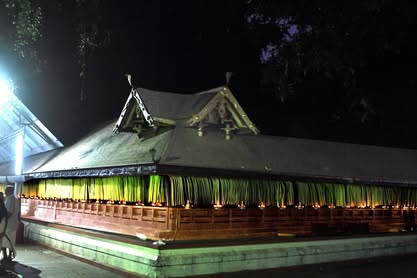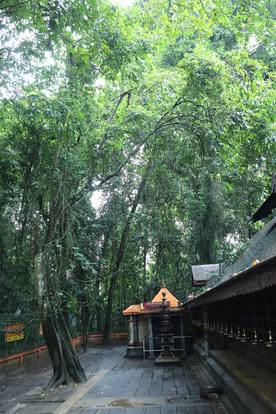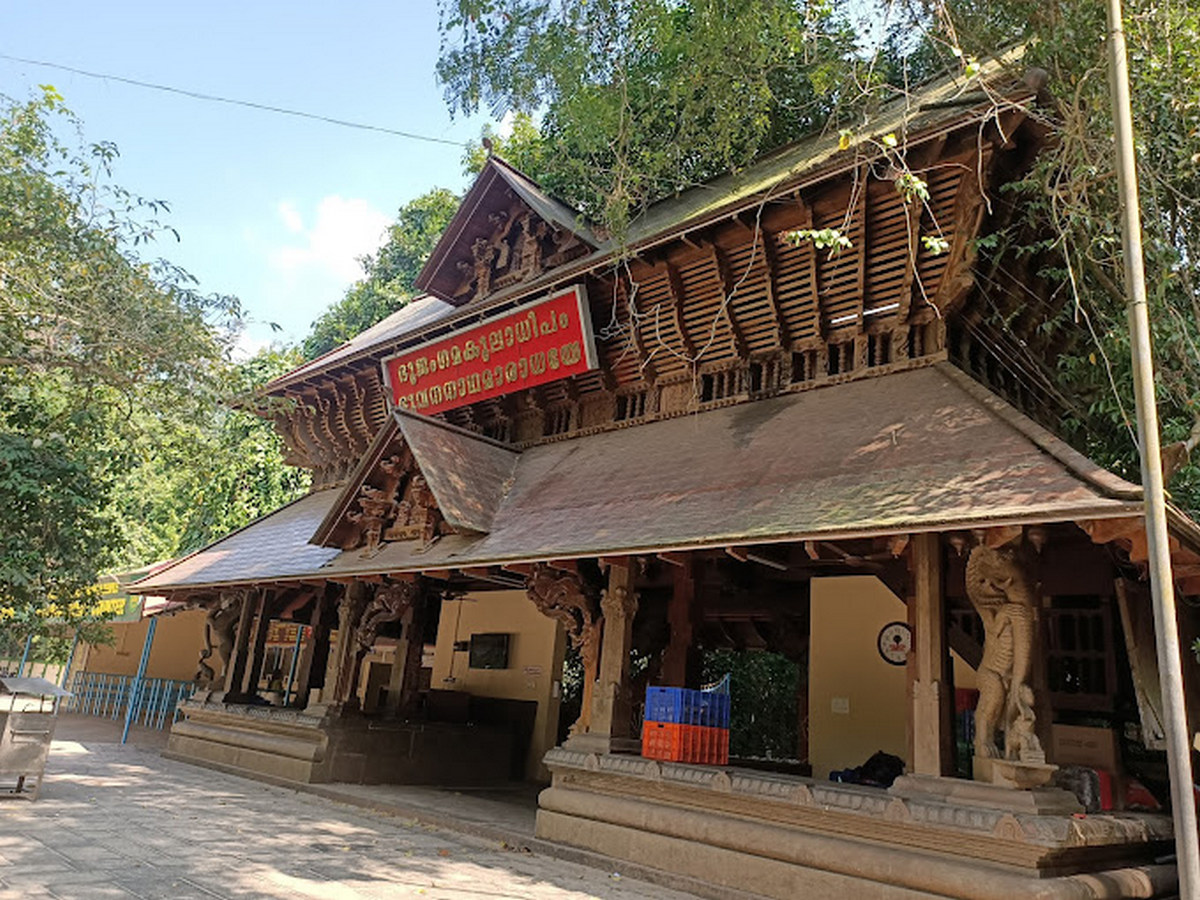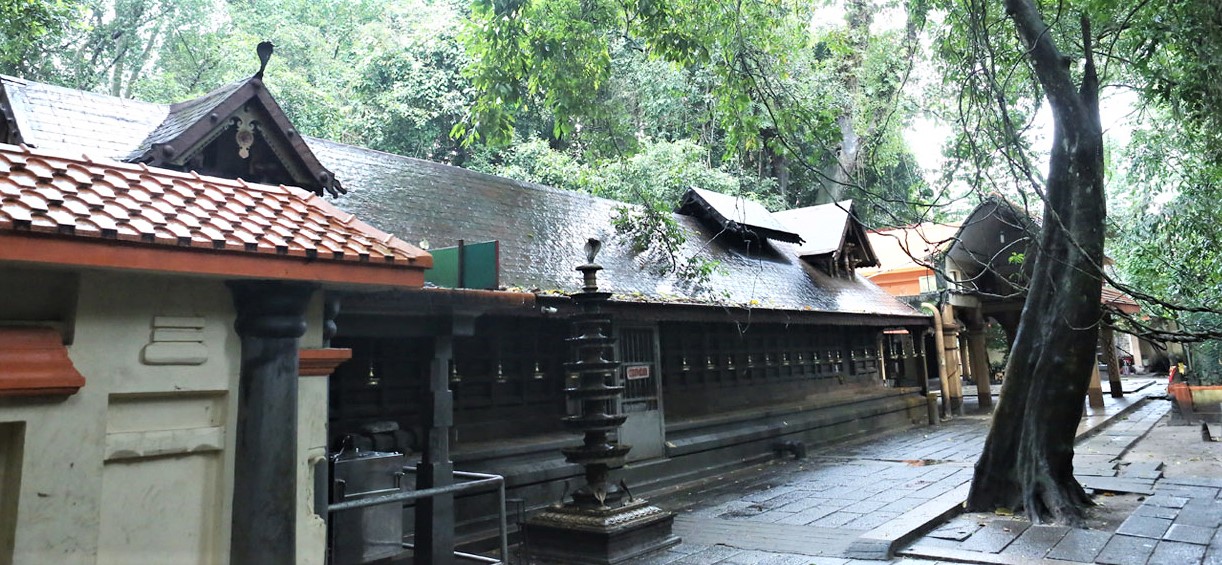Mannarasala Sree Nagaraja Temple in Haripad is an ancient and renowned pilgrimage site dedicated to serpent gods.

The renowned Nagaraja temple, known as "Mannarasala," is situated in a serene forest clearing in Haripad, characteristic of many snake temples. This temple boasts more than 100,000 representations of snakes adorning its pathways and surrounding trees, making it the largest of its kind in Kerala, India. Couples desiring to conceive visit this sacred site to offer their prayers, and upon the arrival of their child, they return to conduct thanksgiving rituals, frequently presenting new snake images as offerings.
Additionally, a unique turmeric paste available at the temple is believed to possess healing properties.The legends concerning the origins of a location may not be classified as its historical account; however, the narrative surrounding the development of Mannarasala as a prominent site of veneration for the Serpent Gods is linked to Lord Parashurama, who is commonly regarded as the founder of Kerala. Lord Parashurama, seeking to atone for the sin of slaying Kshatriyas, approached the revered Rishis for guidance.
They advised him to donate a portion of land to the Brahmins. As the son of Jamadagni, Parashurama sought the favor of Varuna to acquire land for himself. In a significant act, he cast the axe bestowed upon him by Lord Shiva into the sea. This act enabled him to reclaim land from the ocean, which he subsequently offered to the Brahmins in accordance with sacred rituals. This newly acquired land became known as Kerala. However, the land was initially uninhabitable due to its saline soil, prompting many to abandon it. Additionally, the dense forests of Kerala were rife with highly venomous snakes, further driving the Brahmins away. In response to this peril, the practice of snake worship was established.
Bharghavarama, distressed by the situation, undertook a penance to appease Lord Shiva. The deity revealed that the solution lay in dispersing the serpents' toxic venom into the soil, achievable through the worship of Nagaraja. Consequently, Parashurama, accompanied by his disciples, embarked on a quest for an uninhabited forest to honor Nagaraja. He discovered an ideal location near the southern seashore of Kerala. Filled with joy and contentment at having found a suitable site for his aspirations, the esteemed Rishi constructed a Theerthasthala to facilitate his penance. Parasurama bowed deeply at the lotus feet of Nagaraja, earnestly seeking to fulfill his purpose.
Nagaraja, pleased by his devotion, granted his wish. Immediately, fierce serpents appeared to release the fiery Kalakuda poison. As a result of this poison's infiltration, the region of Kerala was transformed, becoming fertile and lush with vibrant greenery. Subsequently, Parasurama implored the Lord to bestow his everlasting presence upon the land, a request that was graciously accepted by the benevolent Nagaraja. Parashurama, adhering to Vedic traditions, consecrated Nagaraja, who embodies the essence of Brahma, Vishnu, and Shiva, in the sacred site known as 'Thirthasthala' (Hall of Pilgrimage), adorned with Mandara trees, presently referred to as Mannarasala.
The deity established here symbolizes Anantha (the form of Vishnu) and Vasuki (the spirit of Shiva). The installation of the Naga deities, including Sarpayakshi, Nagayakshi, and Nagachamundi, along with their companions, was executed in designated locations with the appropriate rituals. Parashurama conducted these ceremonies accompanied by Vedic chants and the singing of Sama, performing rites such as Abhishekam, Alankaram, Neivedyasamarpanam, Neeranjanam, Sarpabali, and other offerings that delighted the serpents, thus ensuring their contentment. He also established Durga and various other deities in different locations, appointed Brahmins skilled in Tantric practices to conduct poojas, and designated Kshatriyas, farmers, and the Ashtavaidyas, who were esteemed among physicians, thereby fostering the prosperity and lush vegetation of Kerala.
After imparting crucial guidelines to maintain the sanctity of the site, Parashurama journeyed to the Mahendra Mountains to resume his austerities. Many generations passed, and the family of Vasudeva and Sreedevi faced the sorrow of childlessness. In their grief, they devotedly worshipped Nagaraja. During this time, a fire broke out in the jungle near Nagaraja's dwelling, burning it down and injuring the serpents. Vasudeva and Sreedevi, seeing the serpents in pain, cared for them by fanning them with sweet-scented grass, applying ghee, honey, and oil on their wounds, and soothing their bodies with sandalwood ointment. They consecrated the serpents' pits and provided shelter under banyan and deodar trees.
The couple performed elaborate poojas, offering Panchagavya, Nivedyam, and chanting Vedic mantras, with great devotion, to restore the serpents' health. Nagaraja, pleased with the couple's penance and devotion, appeared to them and blessed them with the promise of incarnating as their son. He vowed to stay in Mannarasala as a serpent and protect the family and devotees. The place became known as Mannarasala, named after the Mandara trees that sheltered the serpents.
The couple soon had two children—one human and one five-hooded serpent-child. The brothers grew up together, with the serpent-child, Nagaraja, following his divine instructions. When his mission was fulfilled, he entered Samadhi in the cellar, where he is believed to reside, blessing devotees. The family lovingly refers to him as "Muthassan" (Grandfather), and the nearby jungle, "Appoppan Kavu" (Grandfather's Grove), is his sacred sanctuary.
മണ്ണാറശാല ശ്രീ നാഗരാജാ ക്ഷേത്രം
കേരളത്തിലെ പ്രശസ്തവും പുരാതനവുമായ ക്ഷേത്രങ്ങളിൽ ഒന്നാണ് ആലപ്പുഴ ജില്ലയിലെ ഹരിപ്പാടിൽ സ്ഥിതിചെയ്യുന്ന മണ്ണാറശ്ശാല ശ്രീ നാഗരാജ ക്ഷേത്രം. ഹരിപ്പാട് ബസ് സ്റ്റാൻഡിൽ നിന്ന് മൂന്നു കിലോമീറ്റർ വടക്കുപടിഞ്ഞാറ് മാറിയിടത്താണ് ഈ ക്ഷേത്രം സ്ഥിതിചെയ്യുന്നത്. ശിവസർപ്പും മഹാദേവന്റെ കണ്ഠാഭരണമായ "വാസുകിയും" നാഗാമാതാവായ "സർപ്പയക്ഷിയുമാണ്" പ്രധാന പ്രതിഷ്ഠകൾ. നാഗരാജാവിന്റെ മറ്റൊരു രാജ്ഞിയായ "നാഗയക്ഷിയും" സഹോദരി "നാഗചാമുണ്ഡിയുമാണ്" മറ്റ് പ്രതിഷ്ഠകൾ. ക്ഷേത്രത്തിന് സമീപമുള്ള ഇല്ലത്തിൻറെ നിലവറയിൽ മഹാവിഷ്ണുനാഗവും മഹാവിഷ്ണുവിന്റെ ശയനമായ നാഗരാജാവായ "അനന്തൻ (ആദിശേഷൻ)" താമസിക്കുന്നു.
അനന്തന്റെ പുറത്ത് സാക്ഷാൽ ആദിനാരായണനായ മഹാവിഷ്ണു ശയിക്കുന്നുവെന്ന് വിശ്വസിക്കുന്നു. "അപ്പൂപ്പൻ" എന്ന പേരിലാണ് ശേഷനാഗം അറിയപ്പെടുന്നത്. അനന്തനെ പ്രപഞ്ചത്തിന്റെ ആദിയും അന്തവുമില്ലാത്ത പ്രതീകമായി കണക്കാക്കുന്നു. ഈ ക്ഷേത്രത്തിൽ മഹാഗണപതി, ദുർഗ്ഗ, ഭദ്രകാളി, പരമശിവൻ, ധർമ്മശാസ്താവ് എന്നിവരെ ഉൾക്കൊള്ളുന്ന ഉപദേവതകൾ ഉണ്ട്. നാഗദേവതകളുടെ ആരാധകർക്ക് ഈ സ്ഥലം ഒരു പ്രധാന തീർത്ഥാടന കേന്ദ്രമാണ്. ക്ഷേത്രത്തിലെ പ്രധാന പൂജകൾ മണ്ണാറശാല ഇല്ലാത്ത തല മുതിർന്ന അന്തർജ്ജനമായ "വലിയമ്മ" നടത്തുന്നു. വലിയമ്മ എന്ന പേരിൽ അറിയപ്പെടുന്ന ഈ പുരോഹിതൻ, നാഗരാജാവിന്റെ "അമ്മ" എന്ന സ്ഥാനത്തെ പ്രതിനിധീകരിക്കുന്നു. മക്കളില്ലാതെ ദുർബലമായ അമ്മയ്ക്ക് മകനായി നാഗരാജാവായ അനന്തൻ അവതരിപ്പിച്ചതാണ് കഥ. ഈ ക്ഷേത്രത്തിൽ "ഉരുളി കമഴ്ത്തൽ" വഴി പ്രാർത്ഥിച്ചാൽ, അനേകകാലം ചികിത്സിച്ചിട്ടും കുട്ടികളില്ലാത്ത ദമ്പതികൾക്ക് സന്താനഭാഗ്യം ലഭിക്കുമെന്ന് വിശ്വാസമുണ്ട്.
കുടുംബത്തിന്റെ വളർച്ചക്കും, മക്കളുടെ പുരോഗതിക്കും, സർപ്പദോഷം അകലുമെന്ന വിശ്വാസം ഭക്തരെ ഈ സ്ഥലത്തേക്ക് ആകർഷിക്കുന്നു. സന്താനമില്ലാത്ത ദുഖത്തിൽ കഴിയുന്ന ബ്രാഹ്മണ ദമ്പതികളായ വസുദേവനും ശ്രീദേവിയും സന്താനലബ്ധിക്കായി സർപ്പരാജാവിനെ ആരാധിച്ചു വരികയായിരുന്നു. ഈ സമയത്ത് നാഗരാജവിന്റെ അധിവാസസ്ഥലത്ത് കാട്ടുതീ ഉണ്ടായി. തീയിൽ കുടുങ്ങിയ സർപ്പങ്ങളെ ദമ്പതികൾ പരിചരിച്ചു. ദമ്പതികളുടെ പരിചരണത്തിൽ സർപ്പദൈവങ്ങൾ സന്തുഷ്ടരായി. കാട്ടുതീ അണഞ്ഞതോടെ 'മണ്ണാറിയശാല' മണ്ണാറശ്ശാലയായി എന്നത് ഐതീഹ്യം. മന്ദാരച്ചെടികൾ നിറഞ്ഞ ശാലയെ മണ്ണാറശ്ശാലയായി വിശ്വസിക്കുന്ന ഒരു ധാരണയും ഉണ്ട്. ശ്രീദേവി അന്തർജനം അഞ്ചുതലയുള്ള സർപ്പശിശുവിനും മനുഷ്യശിശുവിനും ജന്മം നൽകിയതായി പറയപ്പെടുന്നു.
മനുഷ്യശിശു ഗൃഹസ്ഥാശ്രമത്തിലേക്ക് കടന്നപ്പോൾ, സർപ്പരൂപത്തിൽ ഇല്ലത്ത് സഞ്ചരിക്കാൻ കഴിയില്ലെന്ന് നാഗരാജാവ് പറഞ്ഞ് ശാന്തമായ ഏകാന്ത സങ്കേതത്തിലേക്ക് പോയെന്നു പറയുന്ന മറ്റൊരു ഐതീഹ്യം ഉണ്ട്. പ്രശസ്തമായ നാഗരാജ ക്ഷേത്രം മരങ്ങൾ ഇടതിങ്ങി വളർന്ന കാവിൻറെ നടുവിൽ സ്ഥിതിചെയ്യുന്നു. മണ്ണാറശ്ശാല ക്ഷേത്രത്തിലേക്കുള്ള നടപ്പാതയിൽ, ഇരുവശത്തും മരങ്ങളുടെ ചുവട്ടിലായി 30,000-ത്തിലധികം നാഗ പ്രതിമകൾ സ്ഥിതിചെയ്യുന്നു. കേരളത്തിൽ ഇത്രയും നാഗ പ്രതിമകളുള്ള ഏക ക്ഷേത്രം മണ്ണാറശ്ശാല ശ്രീ നാഗരാജ ക്ഷേത്രമാണ്. ക്ഷേത്രത്തിൽ നിന്നു ലഭിക്കുന്ന പ്രത്യേകമായി നിർമ്മിച്ച മഞ്ഞൾ കുഴമ്പ് രോഗസംഹാരിയാണെന്ന് വിശ്വസിക്കുന്നു.
ക്ഷേത്രത്തിലെ പ്രധാന വഴിപാടുകളിൽ ഒന്നായ ഉരുളി കമഴ്ത്തൽ, സന്താന സൗഭാഗ്യത്തിനായി നിരവധി ഭക്തർ ക്ഷേത്രത്തിൽ എത്തിച്ചേരുന്നു. ദമ്പതികൾ താളമേളങ്ങളോടുകൂടി ക്ഷേത്രത്തിന്റെ ചുറ്റും മൂന്നു പ്രദക്ഷിണം നടത്തുകയും, ഉരുളി നാഗരാജാവിന്റെ നടക്ക് വെയ്ക്കുകയും ചെയ്യുന്നു. മേൽശാന്തി നൽകുന്ന പ്രാർത്ഥന ഇവർ ഏറ്റു ചൊല്ലി, ദമ്പതികൾ അവിടെ നിന്ന് അമ്മയെ ദർശിച്ച് ഭസ്മം വാങ്ങുന്നു. നടയ്ക്കു വെച്ച ഉരുളി പിന്നീട് അമ്മയുടെ നിലവറയിൽ അനന്തന്റെ മുമ്പിൽ കമഴ്ത്തി വെയ്ക്കുന്നു. കുഞ്ഞുങ്ങൾ ഉണ്ടായിക്കഴിഞ്ഞാൽ, ദമ്പതിമാർ കുഞ്ഞുമായി എത്തുമ്പോഴാണ് ഉരുളി നിവർത്തി ഉപകാരസ്മരണയായി പായസം വച്ചു നാഗരാജാവായ വാസുകിക്കും, അനന്തനും സമർപ്പിക്കുന്നത്. മക്കളില്ലാതെ വിഷമിച്ച ഒരു ഭക്തയായ അന്തർജ്ജനത്തിന് മകനായി നാഗരാജാവായ അനന്തൻ ജനിച്ചതാണ് ഐതിഹ്യം.
Address:
Mannarasala P.O,
Haripad, Kerala 690514



